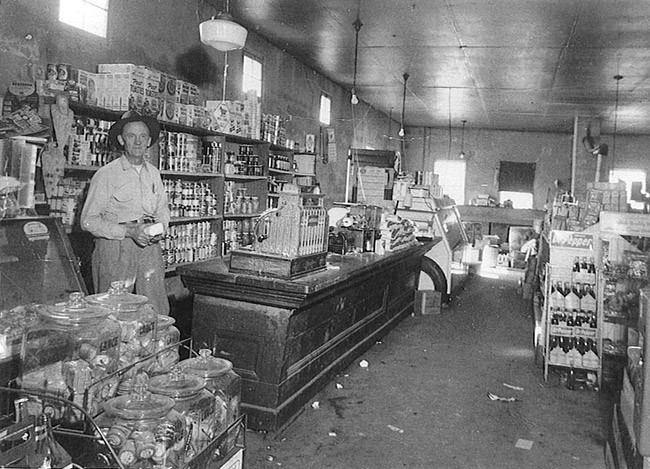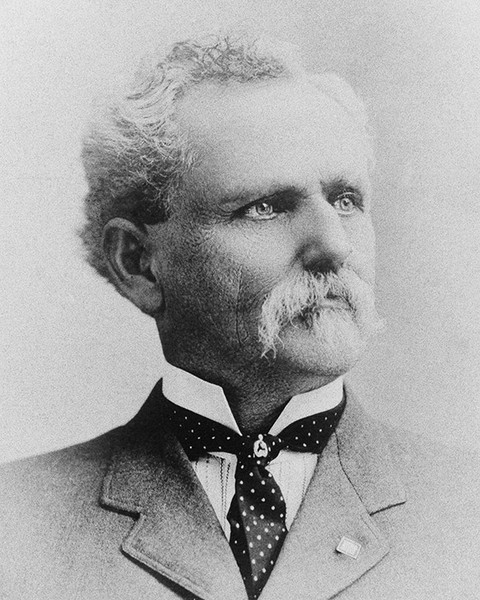Olyphant (Jackson County, AR)
Introduction
Text-to-speech Audio
As your driving on the Highway 367 a person will see a rusted out old building on the side of the road in what was once a thriving railroad town and this building was the cotton gin and merchant store beside it. Olyphant has a famous story about a robbery that became a part of Jackson County and Arkansas history, and put this small community the map for quite some time. Olyphant is a small community outside of Bradford, AR between what was once the Grand Glaise Township of Possum Grape and Grand Glaise, and Newport, AR. Olyphant has an interesting and rich history that played a major role in Jackson County's economy and startup. The community still has some of the buildings still standing built around the late 1800s into the 1900s that was once the epicenter for the community. Olyphant in twenty-first century is considered a part of three surrounding communities of Bradford, Newport, and Oil Trough in the census records, but the residents still consider the area their hometown.
Images
Anderson Mercantile Store in Olyphant around 1955

Owner Nathan Anderson inside the Anderson Mercantile Store around the 1950s

Virgil Y. Cook: Date Unknown

Mildred Ophelia Lamb Cook and Varina Ann Davis Cook (wife and daughter of Virgil Y. Cook)

V. Y. Cook

Virgil Cook at Midland Holm around 1900 near the Oil Trough Bottoms

The Old Olyphant cotton gin owned and operated by Nathan Anderson along with his store.

The newspaper article telling about an eyewitness of the Olyphant Train Robbery

Photos of the captured members of the gang that robbed the train in Olyphant

Men checking the ropes before the hanging of three of robbers from the Olyphant Train Robbery

The hanging of three of four members of the gan from the Olyphant Train Robbery

Backstory and Context
Text-to-speech Audio
Olyphant which is located between what was once Grand Glaise/Possum Grape and Newport, Arkansas was a town developed after the Civil War. Founded by a Kentucky native Colonel Virgil Young (V.Y.) Cook was the wealthiest and most successful citizens between Independence and Jackson County after the Civil War. Serving as a Confederate during the Civil War, Colonel Young would make his way to Grand Glaise in 1866 looking to profit in merchandising. By 1874 he would officially establish residency in Olyphant as an agent for the Cairo and Fulton Railroad, which would eventually be named the Iron Mountain and Southern Railroad. Olyphant became a prosperous farming community by 1895 developing a population of about fifty people with a post office, a store, a gin, a school, and a church. The railroad became a big part of the industry for Olyphant, but logging from the surrounding area along with the freshwater mussel shells became a big part of their economy as well.
A chain of events began to decrease of economic value of Olyphant beginning with the Olyphant School officially consolidating in the late 1940s splitting the children between Oil Trough, Bradford, and Newport school districts, the button business fading away in the 1930s, U.S. Highway 67 being constructed in the 1920s bypassing Olyphant, and in 1960s passenger and freight service with the railroad were discontinued in Olyphant, resulting in the area to become a ghost town. In the twenty-first century the store and gin are still standing but no longer operational, farming still occurs in the bottomlands, and residents travel to Newport, Bradford, Searcy, or Bald Knob to work. Also, locals were wanting to turn the old gin into a museum and reopen the old store.
One of the most famous stories that is known in Jackson County comes out Olyphant called the Olyphant Train Robbery. A seven-car Train No. 51 of the St. Louis, Iron Mountain and Southern Railway on November 3, 1893 pulled off to a side track to let the much faster train the Cannonball Express pass by. About 300 passengers were wealthy tourist coming back from Chicago, Illinois after experiencing the World’s Columbian Exposition that closed on October 30. The Irish conductor, William P. McNally had a very affectionate personality that made his train route very popular with tourist, and at the time of the robbery he was to retire by the end of November. While No. 51 was stalled, gunshots would ring out, resulting in a posse of bandits getting ready to rob the train with the baggage attendant warning the conductor. While the bandits were beginning to board the train, McNally went through the train telling everyone to hide their valuables. A passenger by the name of Charles Lamb would give McNally a gun in which he would then retreat by to the front of the train to defend the passengers aboard. Upon boarding the train, the bandits were beginning to raid the passengers for valuables resulting in an estimated net value of $6,000, after about twenty minutes of holding up the train when the bandits tried to leave McNally would fire at them but one bandit would fire back shooting and killing McNally.
Following the robbery sheriffs from then countries would gather a large posse of people in search of these bandits issuing a large reward. The manhunt resulted in a media frenzy resulting in numerous ‘suspicious’ characters to be arrested and harassed all over Arkansas, the local newspaper the Arkansas Gazette’s front page covered the whole incident. In December 1893 four suspects were arrested and charged: Jim Wyrick, Albert Mansker, Tom Brady, and George Padgett, none of leaving the stated or changing their names, but stayed close to the crime scene the whole time that the sheriffs were looking for them. Three of the four bandits would be charged with the first-degree murder of McNally and sentenced to execution by hanging, but Padgett because he served as a witness got off on the death penalty. Padgett would testify in court that he and Brady concocted a plan to rob the Cannonball Express knowing that money from the Federal Reserve Bank was aboard as a quick rich scheme, but after Padgett had learned that a bunch rich folks were riding the No. 51 which he had personally been on the plan was changed to rob it instead. Days leading up to the robbery the men would ride their horse up and down the track, surveying the area, until the day of the robbery. Before they executed their plan to rob the train all four men got drunk to heavily calm their nerves. Mansker, Brady, and Wyrick were hanged outside the city jail in Newport on April 6, 1894, and before hanged they were asked if they had any last words and all four swore, they were all innocent of the murder.
The story about the Olyphant Train Robbery is still being told all over Arkansas and Jackson County especially by the older generation thats parents or other family members had either witnessed it happen or experienced it through the newspapers or County Sheriff that were on the hunt for the fugitives on the run. Like the rest of Jackson County's history, Olyphant has its own uniqueness that makes the stories and history of area still alive in the twenty-first century.
Sources
Rorie, Kenneth. Olyphant (Jackson County), Encyclopedia of Arkansas. September 1st, 2020. Accessed April 26th, 2023. https://encyclopediaofarkansas.net/entries/olyphant-jackson-county-3575/ .
Reed, Bernard. Olyphant Train Robbery, Encyclopedia of Arkansas. March 15th, 2022. Accessed April 26th, 2023. https://encyclopediaofarkansas.net/entries/olyphant-train-robbery-5744/ .
Campbell Doyle, Sharon Kay. Anderson Mercantile, Encyclopedia of Arkansas. Accessed April 29th, 2023. https://encyclopediaofarkansas.net/media/anderson-mercantile-11067/.
Rayborn, Linda. Nathan Anderson, Encyclopedia of Arkansas. Accessed April 29th, 2023. https://encyclopediaofarkansas.net/media/nathan-anderson-11068/.
Matthews, Linda. Virgil Y. Cook, Encyclopedia of Arkansas. Accessed April 26th, 2023. https://encyclopediaofarkansas.net/media/virgil-y-cook-10268/.
Matthews, Linda. Mildred and Varina Cook, Encyclopedia of Arkansas. Accessed April 26th, 2023. https://encyclopediaofarkansas.net/media/mildred-and-varina-cook-14742/.
Matthews, Linda. V.Y. Cook, Encyclopedia of Arkansas. Accessed April 26th, 2023. https://encyclopediaofarkansas.net/media/v-y-cook-14739/.
Epperson, Delana. Olyphant Cotton Gin, Encyclopedia of Arkansas. Accessed April 29th, 2023. https://encyclopediaofarkansas.net/media/olyphant-cotton-gin-11346/.
Jacksonport Courthouse Museum. Olyphant Train Robbery Account, Encyclopedia of Arkansas. Accessed April 26th, 2023. https://encyclopediaofarkansas.net/media/olyphant-train-robbers-eyewitness-account-8326/.
Jacksonport Courthouse Museum. Olyphant Train Robbers, Encyclopedia of Arkansas. Accessed April 26th, 2023. https://encyclopediaofarkansas.net/media/olyphant-train-robbers-8324/.
Jacksonport Courthouse Museum. Olyphant Train Robbers Execution, Encyclopedia of Arkansas. Accessed April 26th, 2023. https://encyclopediaofarkansas.net/media/olyphant-train-robbers-execution-8325/.
Jacksonport Courthouse Muesum. Olyphant Train Robbers Execution, Encyclopedia of Arkansas. Accessed April 26th, 2023. https://encyclopediaofarkansas.net/media/olyphant-train-robbers-execution-9071/.
Photo by Sharon Kay Campbell Doyle, courtesy of Encyclopedia of Arkansas
Photo by Linda Rayborn, courtesy of Encyclopedia of Arkansas
Photo by Linda Matthews, courtesy of Encyclopedia of Arkansas
Photo by Linda Matthews, courtesy of Encyclopedia of Arkansas
Photo by Linda Matthews, courtesy of Encyclopedia of Arkansas
Photo by Linda Matthews, courtesy of Encyclopedia of Arkansas
Photo by Delana Epperson, courtesy of Encyclopedia of Arkansas
Photo by Jacksonport Courthouse Museum, courtesy of Encyclopedia of Arkansas
Photo by Jacksonport Courthouse Museum, courtesy of Encyclopedia of Arkansas
Photo by Jacksonport Courthouse Museum, courtesy of Encyclopedia of Arkansas
Photo by Jacksonport Courthouse Museum
